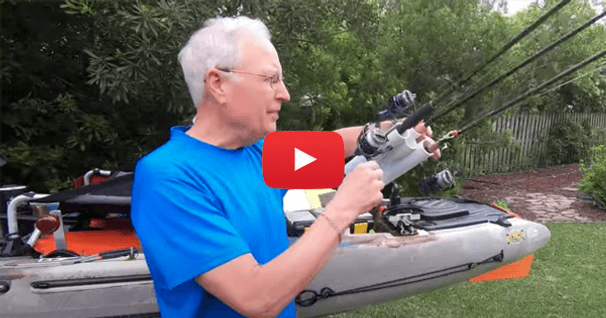Get Ready for Spring Fishing
I don't know about you, but I'm ready to get outside! Up until now, old man winter has been pretty kind to Florida - so far. That's good, and that's bad. Good, because I've been able to get out on the water a lot more than this time last year. Bad, because I haven't done my normal necessary "Spring Cleaning" and prep work. Like most of you, I fish when I can and as often as I can. But as I tidy up this article, it's 43 degrees. The high tomorrow will hit a balmy 60 degrees, with 25 mph winds. I know, the resulting wind chill is only 56 degrees, but this is Florida people! So now is a good time for me to break free from the icy grip of winter, do some gear maintenance, and get ready for what looks to be a great 2013 fishing season.
Regardless of what species you target, we all still deliver the bait/lure the same way, and collect the prize the same way. Rod, reel, line, and hook. So let's begin at the beginning:
THE RODS: I fish in a salty environment, so corrosion is always a concern. But as it turns out, rust is the real enemy. It's seems logical to blast the rods and reels with the hose once I get home, but that's not necessary - let me explain why. Unless you dunk the rods, all you really need to do is wipe them off with a slightly damp washcloth. Rinsing may remove the salt but will push water into places you can't dry, and that leads to rust. Metal guide frames can rust/corrode quickly, so take one of those WD-40 wipes and apply a thin coat. Also, take a cotton ball and rub around the guides to check for cracks or burrs. If you find any damage get the guide, replace it so it doesn't ruin your line.
THE REELS: Does this picture make any sense to you?
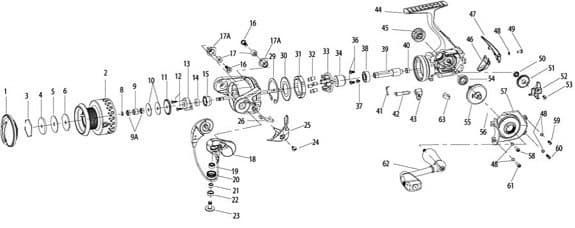
Me either.
I see about 63 things that if allowed to roam free, would most certainly seek refuge under my workbench - never to be seen again. That's why I don't service my own reels. Instead, once they start to stick, I take them to a repair guy. Some things you just leave to the pros, since they do it every day. My reel guy advised me years ago (after annually replacing rusted parts) to NEVER rinse a reel, but to only wipe it down like I do the rods. I've had the same reels for a long time, some for over 10 years … fishing salt water … often. So, I'm a believer. If you dunk it and can make sense of that drawing, go for it - but don't rinse the reel. That just equates to more work for you. When in doubt, call your reel guy.
But you can do a few things on your own, provided your reels seem to be in good shape. Consult that owner's manual first, but you can oil the bail arm and lube the gears, according to the specs provided. Next, grab another cotton ball and use it to inspect the bail arm and spool edges. If they're not smooth, your fishing trips won't be smooth either.
THE LINE: I've found that braided line tends to let you know when it's time to respool. Yeah, once you go a season or two and routinely cut out the wind knots, next thing you know it's time to respool. For roughly the price of a couple good lures, you can respool a reel and then cast 1000 lures with confidence … pretty good trade off. You have a couple of options available. You can take your reels to most any tackle store and get them respooled on that neato machine. They always do a great job, each reel will be exactly the same. But, it's likely that it "can" be costly, since you always end up buying other stuff you "need". Or, you can respool your reels on your own - on your time - with a beer close by. Over the years I've tried all sorts of homespun methods to hold line, keep even tension, etc. Did you know that if allowed to roam free, a spool of line will also seek refuge under my workbench and end up having cocktails with rogue reel parts? There are a lot of solutions available these days, but the absolute trick is the winner in the Best Of Show/Accessory category from ICAST 2012 … the Ultimate Line Winding System.
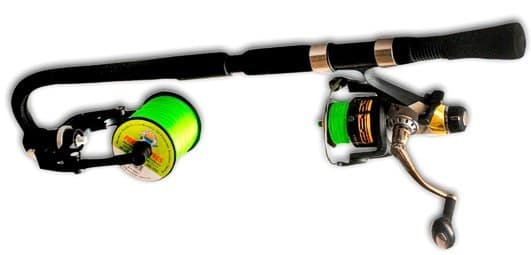
Put your reel on a rod and wind up the line - brilliant! This device is deceptively simple and does a great job. It will also save you money. See, if you're like me, you really don't "need" many things from the tackle store. So respooling at home will save you from making those semi-needless extra purchases.
Check out the website and videos here: Ultimate Line Winding System
NOTE: Before you respool, put some red electrical tape on the empty spool. This gives the backing monofilament something to grab on to, and also is a visual indicator letting you know if you're about to get spooled by a big fish.
THE HOOK: The absolute common denominator for all sporting anglers is the hook point. All the prep and purchases in the world can't compensate for a dull/weak hook. This is a simple and relatively affordable fix - buy more hooks. If you sharpen last years' treble hooks, you get a great point for the moment, but you also remove any remaining protective coating. Rust will happen, and you be replacing that hook anyway, not to mention the potential to lose fish due to a weak hook. Jig heads are cheap enough to be disposable, but high end lures are certainly worth a hook change out. I buy these replacement treble hooks in bulk, and will refurb a dozen lures at a time. Aftermarket hooks are almost always better than original equipment anyway. Your hook can never be too sharp, or too strong. Invest in a good pair of O-ring pliers, a good pair of needle-nose pliers, and a pair of reading glasses from Dollar Tree.
THE PADDLE: This is a quick fix, provided you can still get the paddle apart. Once the paddle is apart, wipe the ferule down with a warm wash cloth. There's no need for lube here as you really want this to be a snug union. I'm a Hobie Kayak kid (pedal-propulsion), so my paddle doesn't see much game time, and therefore it stays together. And at this point, I'm sure it's forever.
THE PFD: Yes, check that life jacket. Make sure the whistle you have attached still works. I tested one of mine recently and after years of going on boat rides, all it would provide was the sound of air. I replaced it. I also have a poorly burned CD in the pocket, since that also makes a great reflector. Finally, put the PFD on and make sure it's still adjusted for a comfortable fit.
THE BOAT: Plastic kayaks are very forgiving, and due to this we can be quite abusive. I rarely wash my boats though they always get at least a half-hearted rinse after a weekend of use. But, when I can muster the energy, I give them a good hand wash and take a few extra seconds here and there to inspect the seams, ensure rudder cables are in their holders, and check for excessive scratches.
We all will occasionally drag our boat to the shore, and that stern can take a beating. By design and default, that ends up being a pretty strong/thick piece of plastic back there. But definitely check it from time to time. Should you actually wear a hole back there, it can be patched easier than you think. Your paddle store may give you "that look" when you bring it in, but 10 minutes with a heat gun and some spare plastic and you'll be good for another 30,000 miles.
MISC GEAR: If you use straps when transporting your kayak, make sure you can find them and make sure they haven't dried out. Check your anchor and anchor trolley to make sure you don't have any frayed line or corroded/sticking parts that need to be replaced. Lubricate your rudder and drive system, if you're so equipped. Think about a time when you finally got to the water and forgot something, or something didn't work - prevent that now.
TACKLE SELECTION: In past articles, I've mentioned being able to do more quality fishing as a result of taking less gear. Over the years, I've gone from taking 5 rods and 70 lures (probably an understatement) to a semi-stuffed milk crate and 2 rods.
The reason for this severe culling is two-fold: #1. I know what lures I'm most confident with based on repeated success and familiarity with performance and action. I will toss them in different ways in different conditions, rather than swapping out lures if depth changes or I encounter structure. More time with a lure in the water means more chances to catch fish. I choose lures that give me the best chance on each cast. Everything in my tackle box earned its slot because it performs for me, and I perform with it. Much like golf, the devil is in the details. And, there's only so much room in the bag.
Most days, I carry one rod and a select group of lures in one double-sided case. Here's the breakdown:
TACKLE CASE - SIDE 1 (top to bottom)
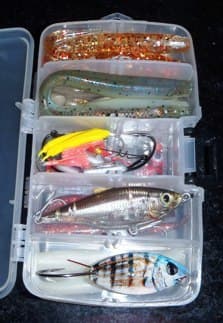
Sections 1 and 2 • MirroLure Provoker (Weedless, scented, balanced for a long cast, tough)
Section 3 • Rockport Rattler LunkerMax jigs (Mustad crazy sharp hooks, rattle that makes fish ask "what's that?" rather than "WHAT'S THAT !!!") • Doc's Goofy Jigs (Anything that swims will go after a jig. The small teaser hook gives you 2 chances to connect)
Section 4 • Live Target Spanish Sardine (aka "greenback") (Perfectly balanced lure with a rattle chamber, "Live Target" is correct)
Section 5 • Capt. Mike's Pinfish Weedless Willow Spoon (If it's a salt water predator, it eats pinfish. Pinfish live in grass and this weedless lure takes you there)
TACKLE CASE - SIDE 2 (top to bottom)
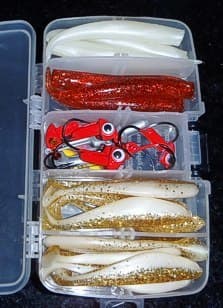
Sections 1 and 2 • MirroLure Lil' John (Scented, tapered tail so fish won't pull them off - instead they get pissed off and keep coming back. Casts like you can't imagine)
Section 3 • Rockport Rattler Original and QuickLock Jigs (same concept as above …and don't shake these near your ear to hear the rattle unless you want another piercing)
Section 4 & 5 • 12 Fathom 3" Shimmer Gold Fat Sam Mullet Kayak guide (Neil Taylor) turned me on to these 3 years ago. I buy them by the pillowcase (100 ct) now.
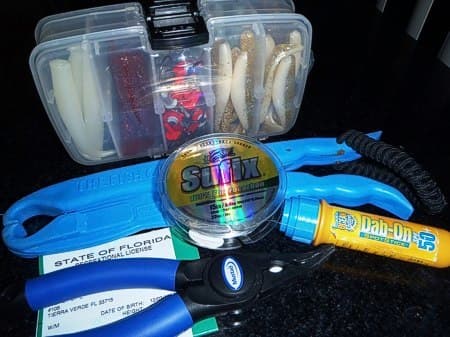
Reason #2 for my severe gear culling: I have proof that the process works.
In January, we had a series of 80 degree days. The kayaks stayed in the water all weekend. We headed out one morning just to cover some water and relax a bit. I grabbed one (1) rod rigged with my go-to softbait (12 Fathom Fat Sam Mullet), put a couple extra of the same softbaits in my pocket, and stowed a washcloth for handling fish. in the picture below, you'll see a decent sized redfish, caught about 1/2 mile from my backdoor. The lure hanging from its mouth is that 1st lure. I had to discard it because it got destroyed. I'm OK with that. I've since upgraded jigheads.
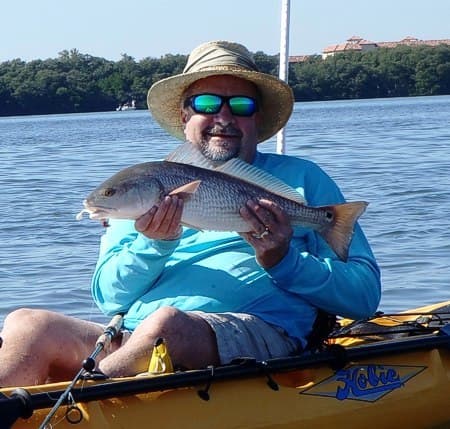
his is a Sheepshead that I caught about 30 minutes later. I was using the same type lure.
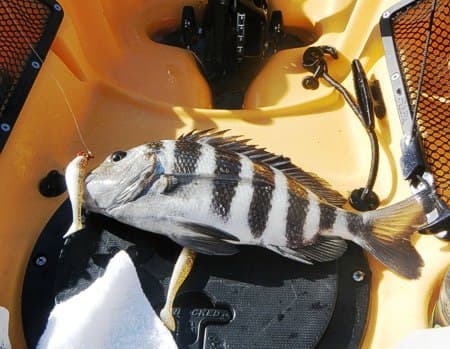
The moral of the story is that because I travelled light with lures I'm confident in, I hit the water quickly which left more time for fishing - it's that simple. I knew this was just going to be a quick "ride around the block", so I grabbed what was on my workbench. Since then I assembled that double-sided tackle tray and just keep it on the kayak in a side pocket, and reload once I get back home. Right now, you're mentally reliving past successes. Fill that tackle box with more good memories and fewer alternatives. Try new things of course, but never forget what works.
It's time for you to check off your gear:
Rods
Reels
Line
Hooks
Paddle
PFD
Boat
Misc.
Gear
Tackle
Selection
Now Go Fish!
Oh yeah, it will be in the low 80's next weekend. I'm ready. Are you?
See you out on the water …
"Many men go fishing all of their lives without knowing that it is not fish they are after"
~ Henry David Thoreau
Related Articles
Learn how to make a pivoting rod holder that will keep your rods out of the way when you don't need them…
Watch and hear the story of how Raf Vargas caught a 170lb dogfish tuna. After hooking it at a depth of…
OK, you've decided where to put your rod holders, and what type of rod holders will go there. In this…
Paddling.net has always given me plenty of room to not only discuss paddle fishing things, but other…
